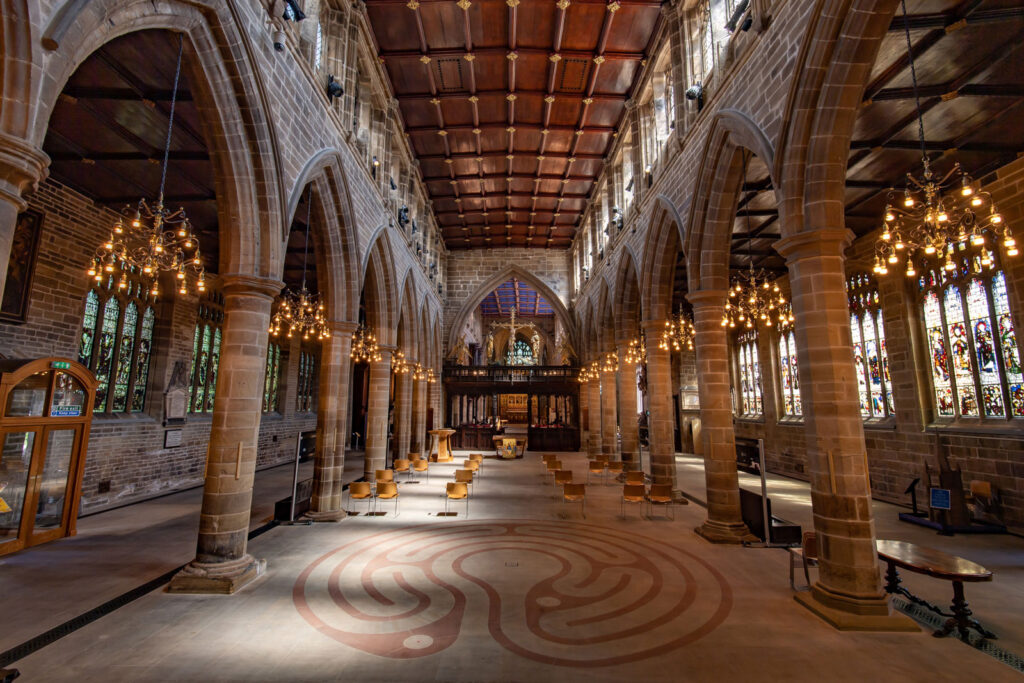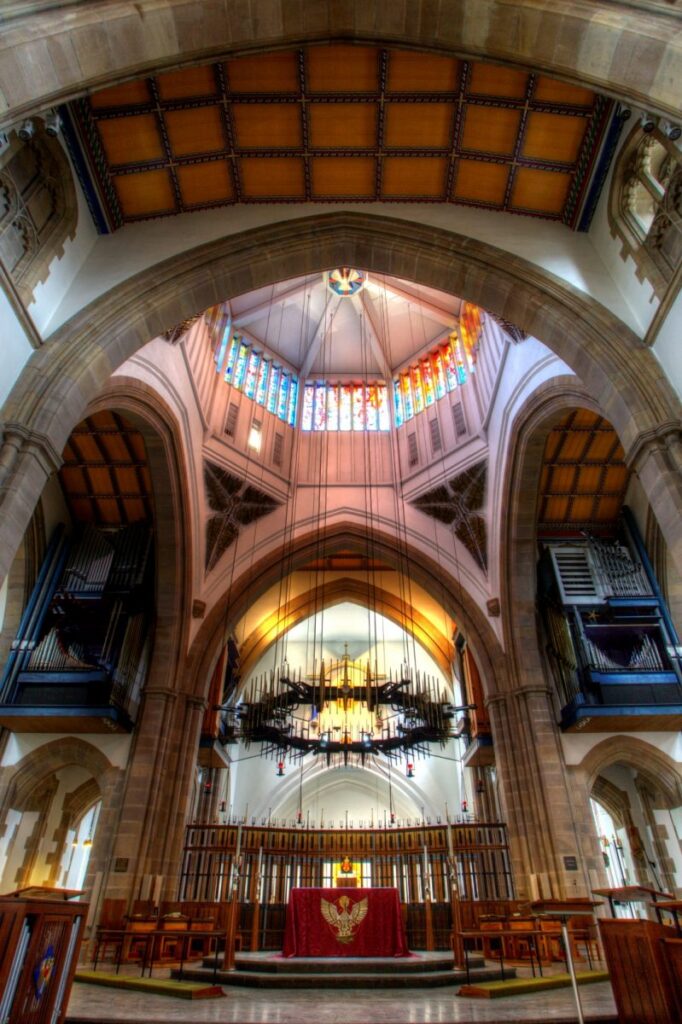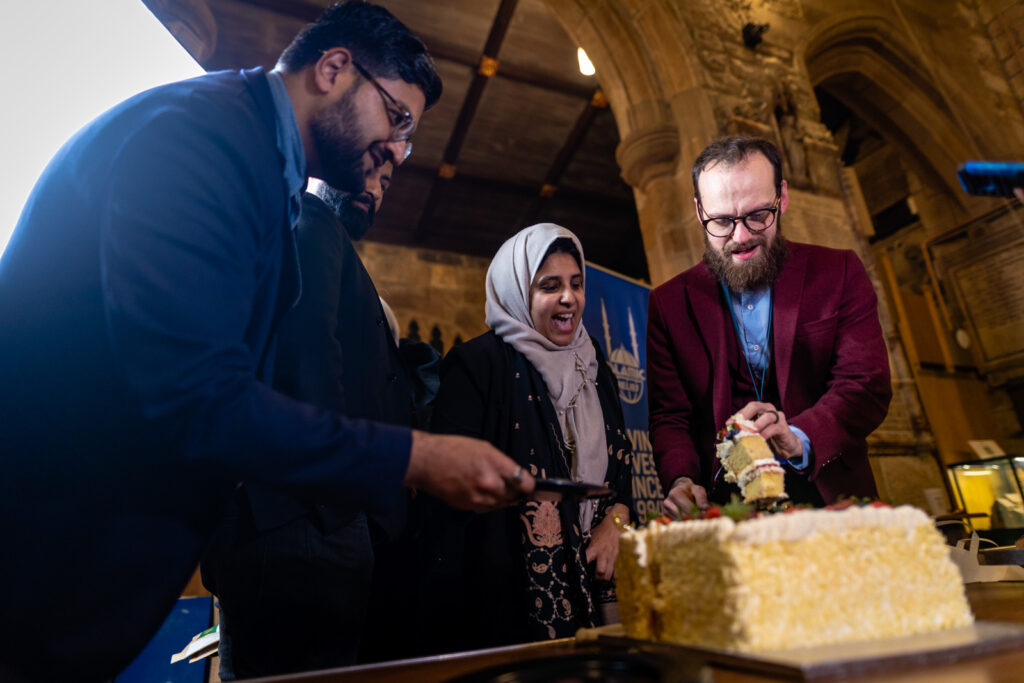When I started as Interim Canon Missioner last year (before being invited to take on the full time role as Canon for Intercultural Mission and the Arts in January), I joined Rev. Canon Philip Hobday who had only recently been appointed as Canon Missioner at Wakefield Cathedral. I invited myself to go and have a look round Wakefield as one of our sister cathedrals in the Diocese of Leeds and to get to know him and see how we might work together. He had already been in contact with our counterpart in Ripon, Rev. Canon Matthew Pollard who started as Canon Chancellor at the same time, in the hope that we might support one another.
I greatly appreciated my time with Philip and our visit raised lots of questions around models of cathedral ministry, particularly, in our case, being one of three cathedrals in a diocese (unique in the Church of England) and also being in post-industrial towns/cities. My reflection, after my visit, was that I went too soon. Philip and I hadn’t gained enough experience or insights in our contexts. Our conversation was, therefore, much more about sharing aspirations. That was still beneficial but I now want to visit again and have deeper and more detailed conversations with him and, indeed, Matthew in Ripon; different as that context is to Bradford.
If three new Canon Generals (the common name for residentiary canons who are not precentors) starting in post at the same time was not interesting enough, in December, Rev. Canon James Lawrence began as Canon Missioner in Blackburn Cathedral. James and I have a very tenuous link through a mutual friend but I was very excited to hear that he was beginning in cathedral ministry with me. He was quickly adopted into the small, informal Canon Generals network. The group also extends to Rev. Canon Maggie McLean, Canon Missioner at York Minster who has been in post longer than us all and brings a wealth of experience.
As I had reflected that my visit with Philip in Wakefield was too soon I gave James six months to settle in before asking if I could visit him in Blackburn. I was keen to visit Blackburn because, like Wakefield, it has a very similar history, foundation and population demographic to Bradford. Blackburn became a diocese in 1926 only seven years after Bradford. The cathedral was created from a large, central parish church and over the next decades (during the great financial challenges between the two world wars) expanded and redesigned the building. The design, therefore, in both, is 1950/60s in style. Around this time the British wool trade, which was a large industry in both Blackburn and Bradford, began to shrink as cheaper products were imported from elsewhere. Bradford Diocese was dissolved in 2014 and, in this way Blackburn and Bradford differ in status slightly. But there are great similarities still, in multi-faith dynamics and demographics as well as in economic indices. For all these reasons it was going to be useful to go and see how the team at Blackburn Cathedral were responding or reflecting on their own future.
I knew James and I had similar methodologies of reflection and research and was delighted when he not only agreed to welcome me but then produced a thorough tour with meetings with key members of staff. In advance he contacted his staff team and clearly outlined the purpose of my visit: to be an opportunity for mutual learning and reflection on our models of ministry and mission. I was not disappointed with my visit. Here are my two main takeaways.
Cathedrals, like Blackburn and Bradford, who are situated in small but ethnically and religiously diverse towns/cities must quickly acknowledge that faith is a cultural object. What I mean by that is, quite simply, for the global majority, faith is not relegated into the private realm and plays a significant role in public identity. This is because, as I was reflecting with James in Blackburn, other nationalities, ethnicities and cultures that we encounter day to day have a deep recognition and appreciation for how faith shapes and/or has shaped their native/historic cultures. Faith for most other peoples is still able to be proudly owned culturally. The secular West is an outlier in this respect and so, for those of us working amongst global majority heritage communities, we are faced with the challenge of what it means to be a confident Christian community in Britain today. The historic and classical liberal approach to Christian mission and civic engagement is no longer working when faced with people whose faith is central to their public identity and whose differing culture is also lauded by our secular society in Britain.
The cultural value in diversity and celebrating difference has a strange shape to it in its current form, in my mind. I continue to reflect on the selective way in which our current society goes out of its way to highlight and amplify different, often conflicting, faiths and cultural heritages. Mainly white, middle-class people who feel divorced or estranged from their own religio-cultural history seem to spend so much time promoting the faith and cultural heritage of others and express appreciation for their beauty and power. They stop short, however, of adopting it for themselves. Why is that? Is it a kind of faith tourism which demands nothing of them but where they feel virtuous for embracing it publicly. The same embracing does not happen with the public expressions of Christian faith and heritage. This is where cathedrals find themselves challenged. Gone are the days, or they are going as we speak, when we are cultural centres producing socially valued cultural expressions. For this reason we are driven to remain relevant by importing other cultural events (even if they are jarring) in order to attract people into our costly historic buildings. 21st century Britain does not flock to the Church as a connection to our shared past because modern Britain seems to want to cut itself off from its past.
Sure there are some painful and difficult things in our collective past but if we are not willing to be reconciled to it then we will continue to float adrift from any potential cultural narrative that could unite us. Without an historic story our identities will have no roots and will not survive the storms of our current age. It is this very problem that the smaller, more industrially shaped cathedrals must lead on if all cathedrals and, indeed, Christian communities are going to be renewed.
Leading on from this, I was greatly encouraged that in both Philip in Wakefield and James in Blackburn I found young (ish) academics who are keen to think theologically about these very practical issues facing our cathedrals. Both of these partners were not embarrassed about asking challenging questions of the status quo of cathedral ministry. It has been even more encouraging because I have long felt called to cathedral ministry but have never seen someone like me doing it.
There is a type… If you know, you know.
I’m not dismissing them nor criticising these fellow cathedral ministers but there is a certain person who fits ‘cathedral ministry’ and if we don’t at the start, we somehow get shaped into it. I am not looking forward to my seemingly inevitable transformation! I don’t know if it is the highly public nature of the role that pushes us towards a more performative persona or the privileged positions associated with our work that give us an inflated sense of our own abilities. Somehow, at some point we fall for the temptations and traps of cathedral life which means we fixate on processional orders, protocols, historic traditions, etc. and our egos expand within the shrinking ecosystem that is our particular cathedral.
I feel it within myself already. It begins subtly with the sheer scale of financial pressures and, alongside that, cultural expectations. I have started explaining to my peers who are in parish ministry that being in a cathedral is like the parish but more so: all the challenges are scaled up but, thankfully, all the benefits and opportunities are too. The problem comes when you succumb to repeatedly dropping your guard and allowing things to happen without consideration or reflection. I get why! We don’t have the time or the energy but step by step, precedents are set and accidents become habits become practice become strategy.
It is in this time and resource poverty that the cultural pressures from other organisations and individuals with their own political and personal agendas just wear us down and we take the easy road of least resistance. Risks are not worth it. Optics are! And, again, I get it! This is what I was touched by meeting with James and speaking candidly with him about our hopes for our own futures but also the future potential of cathedral ministry, if only it could be re-framed: there is a new breed of ministers who are joining the ranks of the AEC. I am glad that I have someone who is young enough and still idealistic enough to keep me from slipping into the full pastiche of a cathedral dean of the 1970s!
Our country and society does not need cathedrals to ‘absolve an entire people, unquestioned and unconditionally’ (Dietrich Bonheoffer, Discipleship (Minneapolis: Fortress Press, 2003) p.53), nor to open our doors and meekly ask “if we could but beg a few moments of your time to ask that you might consider giving a few pence to our collection.” In the post-industrial areas like Blackburn and Bradford where families are struggling not with philosophical issues of identity but with practical things of unemployment and poverty, where popular culture is increasingly passing them by and has no relevance to them, it matters who the Church is seen to be blessing, partnering and dialoguing with and the language they are adopting. It is in this confusing and traumatic time that the Church needs to be robust in our proclamation and coherent in our offer of an alternative solution to the problems of our time. Seeking to agree with the often incoherent and conflicting cultural narratives in the public square will not bring Jesus Christ and his Kingdom into the places we are called to evangelise.
Interfaith work, as with intercultural work, is not about keeping silent or denying the very real and significant distinctions between our very different worldviews. If we pretend that we are all the same we undermine all of our beliefs and we are all poorer for that. Instead it is about being rooted in our heritage and being able to see it with all its strength and with its challenges. It’s about being clear as to what it is that is unique about your own faith and the faith of our friends and neighbours. It is about being hospitable in seeking our own healing, humbly accepting where we need to repent, and seeking the healing of those who we differ from.
I am grateful that I have colleagues who are ready to wrestle with the very keys of discipleship as a catalyst for mission in the very public life of cathedral ministry. I only pray that I will remain sharp and passionate about it myself.



